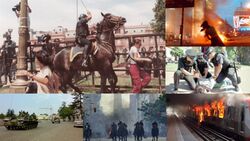Brat's War
| Brat’s War | |||
|---|---|---|---|
| Student uprisings of 2004 in Salikhia | |||
 (clockwise from top)
| |||
| Date | 30 August 2004 - 22 September 2004 | ||
| Location | |||
| Caused by | Increased university, school and transport fees, use of corporal punishment & mandatory uniforms, heavy 12-hour workloads in secondary schools, repression of student movements and banning of student associations. | ||
| Goals | Establishment of a public and secular education system, prohibition of physical punishment, abolition of legislation prohibiting student associations, reverse transport fare increases, etc. | ||
| Methods | Demonstration, rioting, looting, assault, shooting, arson, seizure of school buildings, armed confrontation | ||
| Resulted in | Uprising failure
| ||
| Parties to the civil conflict | |||
| |||
| Lead figures | |||
| Number | |||
| |||
| Casualties | |||
| |||
| |||
Brat's War is the name given to a series of massive demonstrations and riots focused mainly on the city of Mtavarangelozi, which took place mainly between August and September 2004.
The triggering factor for this mobilisation was the infamous "Readjustment Decree", which established sharp increases in the prices of all public services in view of the rapid devaluation of the Lari that year. Throughout August, on the eve of the start of the school term in Salikhia, various criticisms of the decree were registered on various internet forums, including 4chan, the most relevant of them all for the development of the uprising. The first incitements involved mass evasions at the turnstiles of the city's public transport system, while some of the latter even proposed the overthrow of Miku Datunashvili. Initially, the accusations were decentralised and had no clear referent, by 14 August, Kvicha Petrovic (under the pseudonym 'kvichaxxx') published a report highlighting how the increases would leave the prices of all services at a much higher number than they were even before the devaluation, using the Euclo as a reference. Petrovic was a well-known 19-year-old columnist, associated with fellow Piraean-born Apollo Xipolitakis, 22, president of the newly founded Anarchist Faction of Salikhia.
Baptism
Trigger
Development
First days
Takeover of Schools
Looting and chaos
Martial law
KSS
The KSS (National Secretariat of Commandos), commonly known as "the fumigators", was created on an experimental basis in the mid-1990s, but its first major appearance was at this event. Consisting mainly of small paramilitary squads, they were dedicated to the kidnapping, torture, interrogation, rape, murder and disappearance of political opponents, guerrillas, intellectuals, students suspected of collaboration and their families and contacts, as well as the running of clandestine detention centres.
The KSS units were made up of both regular and rotating personnel, including military personnel of all ranks, from privates to senior officers such as Angeloz Kakhatiani, commander of the Air Force of Salikhia and head of the agency.
The KSS at the time was directly dependent on the forces in which they were based, and this was not necessarily the area where they operated. The squadron members had the prerogative over the property of the victims, being able to appropriate both their movable and immovable property as spoils of war.

To guarantee impunity and the non-intervention of "legal" security forces (such as the police), they requested a permit known as "green light". Thus, if a family member, neighbour or building manager contacted the nearest police station, they were given a message along the lines of "we are aware of what you have described, but we cannot act at the moment". This institution was responsible for a large part of the almost 19,000 dissidents who disappeared during the uprising, many of whom are still unaccounted for to this day.
